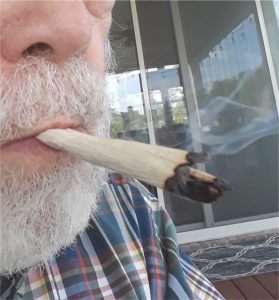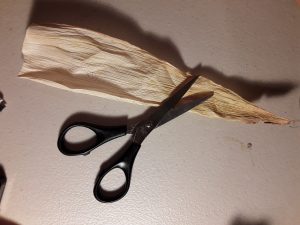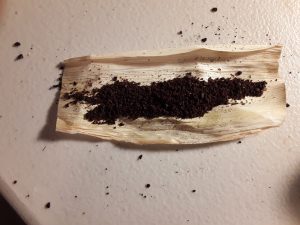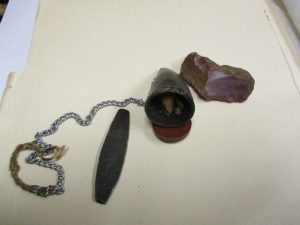20 Cigarro de Palha
Cigarro de Palha
Caipira traditions prevailed in the back country of Mato Grosso, Brazil in 1965. Rolling shredded tobacco into a corn husk enabled a long smoking tradition. Packaged cigarettes were just becoming available and people did not always have the money to buy them. 
Corn husk cigarette. Photo by Rick Bein 2020
They grew their own tobacco and while it was still green, harvested the leaves and twisted them into ropes. The rope tobacco hung in the barn and cured over a several months before it was used. A man normally carried a three inch piece of cured tobacco rope in his pant pocket from which he shaved off enough to roll a cigarette.
The process was not that easy however, as it also required some kind of leaf to contain the tobacco. Dried leaves from trees had been used in the past. But dried corn husks proved to be excellent cigarette papers. They could be trimmed to about the right size and were very dry and burned well with the slightly damp tobacco rolled up in them. Usually several corn husks would be trimmed in advance and would ride along in the shirt pocket ready and available whenever there was a nicotine urge.
Smoking a cigarro de palha was not something taken casually. The process required the smoker’s complete attention. The ritual involved pulling out a knife of some sort and shredding some of the rope tobacco until there was enough loose tobacco to make a cigarette.
The tobacco was placed in the palha, or corn husk in preparation to be rolled. It took some talent to roll the cigarette just right so that it would burn properly. If rolled too tightly it would not hold a flame and the cigarette would have to be lit again and again. If it was rolled too loosely the dry fiber of the husk would burn first allowing tobacco would fall out onto the ground.




Steps in preparing corn husk tobacco cigarette, Photos by Rick Bein 2020
Another challenge was lighting the cigarette when there were no matches. Usually the time to smoke was after a meal when embers from the cooking fires were still glowing.
In some cases flint and steel was used to strike a spark that was directed onto some charred cloth which hopefully ignited into a small glowing ember. The end of the already prepared cigarette would then be placed against the ember while the smoker would inhale on the other end. The cigarro de palha would then light.
In the image below there are several items that can solve the problem as long as one has enough patience. This consists of a small drawstring bag which contains the tip of a cow’s horn containing some charred cloth and a wooden lid. There is also a metal file and a flint stone. By striking the stone with the file, a spark is produced. By holding the cow horn receptacle at the right angle below, the spark will land on the charred cloth and create a small ember. No easy task. By gently blowing on the ember it grows big enough to ignite the cigarette when contact is made. Maneuvering all the parts takes some time to complete. Of course this cuts back on smoking.

Caipira cigarette lighter with flint, steel and charred cloth in tip of a cow’s horn.
While in the Peace Corps (1964-65) I enjoyed many of the rural Brazilian cultural practices. On occasion I would smoke a cigarro de palha. In those days it was considered crude to smoke this cigarette because the heavy smoke was irritating to the eyes and nose. It smelled like burning dried leaves and most people smoked these in the open air. In many places signs were posted forbidding the smoking of these cigarettes while the normal paper cigarette was quite acceptable.
One such place was the inside of public buses. There was a sign right up front saying “E proibido de fumar cigarro de palha” (It is forbidden to smoke cigarro de palha).
A bus connected Pedro Gomes to the regional capital, Campo Grande, going one day and returning the next. The driver and the conductor knew me well and we had a good rapport.
One day I decided it would be fun to see what happened if I smoked one of those cigarettes in the bus. I was seated alone about two thirds of the way back. There were a about fifteen other passengers. With a match, I lit cigarro de palha, and in about 5 seconds the driver was scanning his rear view mirror for the culprit. I acted nonchalant and kept the cigarette down low while the driver ordered the conductor to go figure out who was smoking that awful cigarette. I quickly snuffed out the cigarette as the conductor walked down the aisle looking everyone over. He didn’t notice anybody smoking and by that time the smell had diminished and he went back up front and took his seat.
I lit the cigarette again. This time the conductor walked slowly back asking a few the passengers if they were smoking such a cigarette. Having no success, he returned to the front again.
I lit it a third time, and the conductor walked back asking each passenger if they were smoking a cigarro de palha. When he got to me, he did not ask me because he could not imagine that the gringo, the man of culture, would stoop so low to smoke that thing. He continued on to the back of the bus asking everyone. No one fessed up. Perplexed he walked back toward the front and as he passed me he decided I was the only one left that he had not asked and he very apologetically asked me if I was smoking a cigarro de palha.
To his surprise I broke out laughing and handed him the cigarette butt! He was a little shocked but the driver got a good chuckle as he eyed me in the rear view mirror. I laughed back.
Of course this made a good story and he told a lot of people. After that people would kid me about what I had done. Some would ask if I had an extra cigarro de palha!

